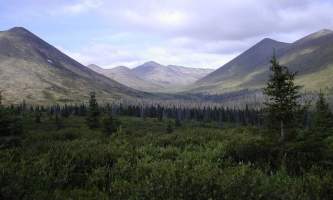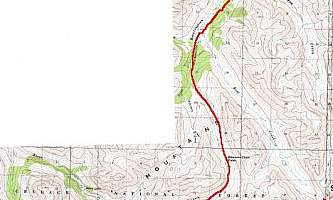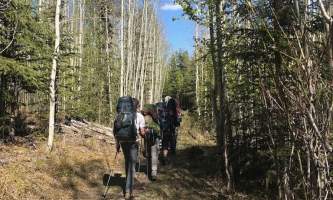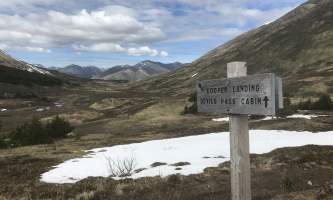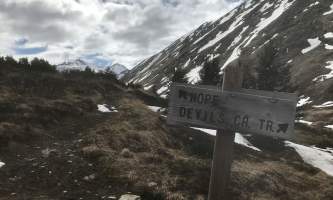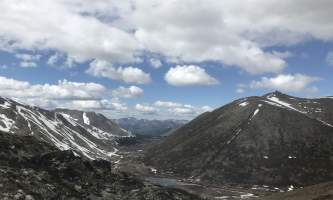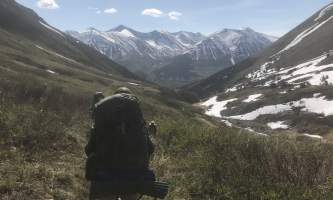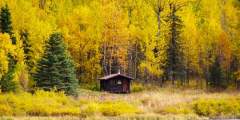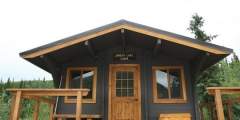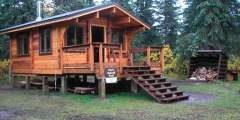Guide to Backpacking the Resurrection Pass Trail
Distance
38 miles
Difficulty
Moderate
The 38-mile Resurrection Pass Trail through the Kenai Mountains is by far the most popular multi-day backcountry route in Southcentral Alaska. Ideal for backpackers and mountain bikers—and a great destination for skiers and snowshoers during snow season—the trail links historic gold mining areas near Hope with a trailhead near Cooper Landing close to the Kenai River.
It is a true classic, drawing hundreds of visitors over the entire year. Many Alaskans return annually—often taking at least five days to traverse the route.
Why so beloved? It offers a wide-ranging wilderness experience coupled with remarkable backcountry camping infrastructure. No bushwhacking required! You travel through country rich in natural and human history, and then you can usually spend each night either in a campsite with basic facilities or inside a rustic cabin with bunks, table and heating stove. (Four lakeside cabins are even equipped with canoes or rowboats!)
Easy-To-Follow Route
The easy-to-follow, well-marked route rises from mixed spruce-birch forest near sea level through several ecological zones before breaking into open tundra as it traverses a 2,600-foot pass. With only a few steep grades and a generally smooth walking surface, the trail does not require special preparation or gear beyond what you need for regular backpacking. Fit mountain bikers sometimes ride the whole route one-way in a single day. Private parties camping in tents do not need permits in advance.
The creeks have bridges so you don’t have to attempt a stream crossing. The 19 designated campsites and eight public use cabins on the trail feature outhouses and bear resistant lockers, and are spaced out so that it’s easy to divide a full trip into comfortable eight-to-ten mile legs over multiple days.
Activities During The Trek
The route is family friendly and flexible, with many possible side adventures. You can go out for a day or two and return to your start, or tackle a through hike over three to five days, or go longer with more with time set aside for exploration. You can climb the ridges above the pass, or gorge on blueberries in season. Many creeks feature dramatic hydraulics or small waterfalls—Juneau Creek Falls is especially spectacular. Three lakes offer a decent shot at catching fresh fish for dinner.
Travelers will also find plenty of chances to see wildlife or wildlife sign. Moose, black bears, brown bears roam the country. Bald eagles soar on thermals, while forest birds like varied thrush trill in the spruce. Wolf packs live in these mountains, too, along with lynx, marmots, beavers and other wilderness animals. Dall sheep and mountain goats graze up high, and a small herd of caribou are sometimes sighted meandering the open slopes.
Planning Your Trip
First, you will need to prep for a backcountry wilderness journey with suitable clothing, food and gear for the season and duration. Check out our clothing, hiking backpacking and skiing guides, as well as our primer on Alaska weather. While there are plentiful sources of water along the route, it should be purified before drinking.
In general, Alaska backpacking requires carrying a wider range of clothing than you might pack for a summer adventure in a more southern locale. Alaska’s summer climate swings from chilly rain to hot sunshine, and higher elevations can see wintry temperatures or even snow in any month. On a July outing through the Kenai Mountains, however, you should expect temps to range from the 40s-50s at night to 60s or 70s in the day. Always be prepared for rain or foul conditions, but the Kenai Mountains can experience stretches of dry, sunny weather during summer.
When Should You Go?
The prime time to do a summer trip could fall on any week between mid-June through early September, with the heaviest use occurring in July and August. The best chance for extended dry conditions probably falls in early to mid July. June can still see snow in the pass and muddy trails take time to dry out, while rain grows more frequent as summer advances. Still, people traverse the trail in every month, often using skis, snowshoes, snow bikes and (when allowed) snowmobiles. The best time for a snow-season trip may be in March, when you’re likely to find a firmly packed route beneath the long, sunny days of southern Alaska’s (often) dry spring.
Plan 4 - 5 Nights
With 20-plus hours of usable daylight near summer solstice, people do power through in three long days, or even less. But if you’re backpacking the full route one-way for fun and adventure, consider taking a five-day trip that allows you to divide the journey into roughly four segments of 8 to 10 miles each and one rest day. (Mountain bikers or skiers may travel faster, depending on fitness or conditions.)
With enough time, you would have the option to camp two nights in one spot and spend a full day exploring, fishing or just enjoying the scene. Adding extra time also makes the shuttle easier. Driving from Anchorage or another town, dropping off a shuttle car and then returning to your starting trailhead can easily eat half a day or more. And that’s before you start hiking! Many people set up the shuttle, then spend a night near their starting point and begin the hike fresh in the morning.
Start North or South?
The two travel directions offer different flavors of experience. A south approach brings you more quickly to the lake country. It also gets most of the climbing out of the way by Mile 13, leaving you with a long mellow descent toward Hope. On the other hand, a North approach stretches the 2,300-foot climb to the pass over twice the distance, offering a more gradual rise with easier walking and biking, as you slowly move out of the mature forest zone into the alpine realm.
If taking a shuttle ride from Wildman’s, starting the actual hike at the north trailhead near Hope might make the most sense. The vendor’s operation is only a few miles from the south trailhead near Cooper Landing, which makes it easier to coordinate times for catching a ride after dropping off your vehicle.
Cabins or Campsites?
You have two options for accommodations on multi-day trips: rent cabins or carry a tent. In recent years, several cabins have been renovated with new bunks, furniture, flooring, roofing and windows. So you can likely count on a clean and secure (if not gorgeous) shelter for your visit. If you want to rent one of these cabins—or a succession of cabins for night-after-night stays—you must book well ahead of time. Cabins during the main hiking season between May 1 and Sept. 30 are usually taken as soon as they become available, beginning six months in advance of the arrival date. Often to the day. Check with Recreation.gov by searching on cabin names.
Some through-hikers rent a cabin only for a night or two, and tent the rest of the trip. There are many combinations possible. But many people simply backpack or bike camp the whole way.
Campsites are available on a first-come basis and there is almost always space to accommodate late arrivals. Most of them feature campfire rings, bear-proof lockers and outhouses. But there’s no guarantee you won’t find your first choice sweet spot already occupied or crowded during good weather in the middle of the summer or over a holiday weekend. In that event, you may camp in the forest or tundra using no-trace camping practices. People are asked to camp at least 300 feet from any cabin reserved by other travelers. Designated backcountry campsites are available at the following locations: mile 4; Wolf Creek (mile 5.3); Caribou Creek (mile 7); mile 9.6; mile 12.6; East Creek (mile 14.6); as well as miles 22.4, 24.5, 25.4, 27.7, 28.9, 29.6, 30.7, 31.1, and mile 33.7
Hire a Shuttle or Bring Two Vehicles
If you want to hike from one end to the other, you need to set up a shuttle or book a trip on a local trail taxi. While that might seem like a hassle, longtime Resurrection Pass Trail hikers say it’s worth it. Plus, the drive between the trailheads is one of the most scenic in the state, with many of its own attractions (wildlife viewing, fishing, lodge visits, gorges, hiking) along the route. Check out our Seward Highway Drives or adventure links.
Many parties bring two vehicles, dropping one off at the exit trailhead and then returning to the start trailhead in the second vehicle. Give yourself at least two hours to complete the drop-off with time to reach to the opposite trailhead.
The north trailhead is located four miles up Resurrection Creek Road from Mile 15 of the Hope Highway. (Some 85 miles from Anchorage.) The south trailhead is at Mile 53.2 of the Sterling Highway (106 miles from Anchorage.) The one-way distance between the two main trailheads via Hope, Seward and Sterling highways is about 43 miles.
An alternative: The 10-mile Devil’s Creek Trail makes for a shorter shuttle. The trail intersects the RPT at the entrance to Devil’s Pass about 21.5 trail miles from Hope and 16.7 trail miles from Cooper Landing. (The trail intersection is about 2 miles south of Resurrection Pass near the Devil’s Pass Cabin.) Devil’s Creek Trail descends to a trailhead on the Seward Highway about 33 miles from the North trailhead and about 18 miles from the south trailhead.
Call Wildman’s for a taxi or shuttle. The easiest solution for out-of-state visitors or parties with a single vehicle may be to book a ride! The folks at the Wildman’s store at Mile 47.5 of the Sterling Highway offer a shuttle or taxi service to and from Resurrection Pass trailheads for a group rate of $125 per hour. (They also offer drop-offs and pick-ups for Kenai River boaters and transportation to and from other area trails.) Depending upon the amount of gear, the taxi can transport up to six or seven backpackers between the Hope and Cooper Landing trailheads typically for an hour’s fee of $125. People usually drop a vehicle, then ride the taxi or shuttle to the other trailhead and then backpack, hike or bike back to their vehicle. Call 907-595-1456 to figure out what makes sense for your particular itinerary and make a reservation.
Trail Highlights
- There are gorges and waterfalls on the approaches from both ends, and ridgeline tundra hiking above the tree line.
- About 7.5 miles from Hope, you will reach Pass Creek. Pioneer miners maintained a pack trail up this drainage that crossed the mountains to Canyon Creek and the present corridor of the Seward Highway. Many drainages saw such horse packing by-ways in the early 20th century, but exploration can be difficult in the present due to beetle-killed spruce trees toppling along the logical lowland routes and alders growing thick. Intrepid bushwhacking awaits you!
- Once you reach the alpine realm, the trail intersects two side paths that descend to trailheads on the Seward Highway, offering a chance to spend a day exploring adjacent valleys. Summit Creek Trail peels off in Resurrection Pass, while Devil’s Creek Trail descends from the cabin area a couple miles south of the pass. For a lot more detail about these trails, see our Connecting Routes page.
- Lots of travelers spend an afternoon climbing 1,600 feet to the top of the ridge west of Resurrection Pass to experience a stunning panorama that includes Denali and the Alaska Range to the north and the Harding Ice Field to the southeast.
- Devil’s Pass Lake nestles in a dramatic alpine V-shaped valley less than one mile southwest down the Devil’s Creek Trail. Well worth a look.
- Juneau Lake—with two cabins and three campsites in the vicinity—is revered for its beautiful setting and has become a popular summer destination. Experienced trail users often consider it the “gem” of the trip. It often features the best fishing, too, with a resident population of Arctic grayling. Dry fly fishing anyone?
- Juneau Creek Falls is the trail’s premier cataract—a first-day or last-day spectacular! Located about 4 miles from the south trailhead (34 miles from the north), the falls is about 50 yards off the main trail about quarter mile south of the Mile 4.27 campsite. (Watch for a path veering off near a graphic “tent” sign giving the quarter-mile distance to the campsite.)
Fishing and Boating
The southern half of the trail passes three different lakes with potentially decent fishing. Cabin rentals come with use of a canoe or rowboat (depending upon the cabin.)
- Swan Lake twists into a cleft between sheer slopes up a fiord-like valley, with rainbow trout, lake trout, Dolly Varden and sockeye salmon reported.
- Juneau and Trout lakes are broader with good shoreline access. Anglers have reported catching rainbow trout, whitefish, burbot and grayling in Juneau Lake, making it a good destination to try out lightweight fly fishing gear. Trout Lake boasts rainbow trout and whitefish.
- Be sure to check the latest Alaska fishing regulations for updates or restrictions before you go.
- No personal flotation devices are provided with the boats. You must bring your own.
A Few Final Thoughts
- You will be off the grid. Though very popular, the trail traverses remote mountain valleys and requires all the same preparations and skills that you would bring to any other multi-day adventure into wilderness. Plan on being self-sufficient. You and your party will spend whole days up to 15 miles and sometimes more (by any route) from the road system and the nearest outside assistance. Although there may be spotty cell phone coverage in places, especially toward the southern end, assume you will NOT be able to phone out.
- It’s bear country.The Kenai Mountains feature prime brown bear habitat, and the forests abound with black bears. So take all the usual precautions—including storing food in bear lockers or portable vaults, keeping a clean camp and carrying bear spray for deterrence. Make noise and pay attention. Hikers regularly report encounters with or catch sight of both species. Having said that, the trail gets regular human traffic and does not have a reputation for unusual bear problems.
- The Forest Service adds this message: Safety is your responsibility. Be prepared. Let someone know where and when you will return and follow Leave No Trace outdoor ethics along the way.
- Shop before you leave town. Once you leave Anchorage or other towns like Seward or Soldotna for the mountains, there are no specialized camping retailers or large grocery stores along the route. To be sure, both Hope and Cooper Landing feature restaurants, guide services, small stores and museums well worth visiting. But you should plan on leaving town with your trip’s staples and essential gear already in hand.
- Seasonal concerns. Resurrection Pass can still have deep snow well into June. Sections can remain gooey and muddy into July, and trees can topple across the trail any time. The trail is closed to horses and pack stock April 1 to June 30. Motorized snow vehicles can be used Dec 1 through April 30 when December falls in an odd year. When December falls on even year, the trail does not open to motorized winter use that season.
- Winter hazards. There are several snow avalanche paths that impinge upon the trail, identified in the trail guide. If traveling or exploring off trail during snow season, learn to recognize and avoid potential avalanche paths. Some narrow sections with side hills can become icy on the descents into creek valleys, especially north of the Pass, making footing difficult. (Hiking or ski poles can be a great assist.) If approaching from the south during snow season, the Forest Service recommends using an alternative trailhead off Bean Creek Road due to the steep, icy and narrow side hills along the initial climb. (See the Special Considerations on the south trail factsheet.)
For more information:
Current conditions
Contact the Seward Ranger District, 33599 Ranger Station Spur (mile marker 23.5), Seward, AK 99664. (907) 288-3178
Will you see other people in the backcountry?
Probably. This is a popular trail with visitors and locals alike. If you travel mid-week, you may be very lucky and see few other people. If you’re on this trail on a weekend, you’ll definitely encounter people. Enjoy meeting your new trail friends!
Land Manager
GPS Coordinates
Starting Point: Resurrection Pass Trailhead North, 60.86873,-149.63045
Caribou Creek Cabin: 60.78314,-149.67751
Fox Creek Cabin: 60.73109,-149.70988East
Creek Cabin: 60.70490,-149.74849
Resurrection Pass (and Summit Creek Trail junction): 60.64055,-149.72265
Devil’sPass Cabin (and Devil’s Pass Trail junction): 60.62071,-149.75413
Swan Lake Cabin: 60.61248,-149.84008
Juneau Lake Cabin: 60.57525,-149.87179
Ending Point: Resurrection Pass Trailhead South, 60.48376,-149.95314
USGS Maps
Seward B-8
Seward C-8
Seward D-8
For online trail profiles:
Resurrection Pass Trail north access
Resurrection Pass Trail south access
For fact sheets, maps and GPS coordinates:
Resurrection Pass north fact sheet and map (PDF)
Resurrection Pass south fact sheet and map (PDF)
Devil’s Creek Trail fact sheet and map (PDF)
Russian Lakes Trail fact sheet and map (PDF)
Resurrection River Trail fact sheet and map (PDF)
Cost: $-$$
If you choose to camp along the trail and are able to run your own car shuttle, this is a very inexpensive trip. If you choose to reserve one or more of the cabins, they typically cost $75 per night.
Show Map
Points of Resurrection Pass Trail
Forested, with bear locker and tent site. No outhouse.
Forested, with tent site, bear locker and outhouse.
12 by 14 rustic cabin on Resurrection Creek in spruce-birch forest with mountain views. Sleeping bunks for six with space for eight. Equipped with counter space, table, benches, wood stove, splitting maul and hand saw. Outhouse and bear locker.
Campsite close to Caribou Creek Cabin.
Tent site, bear locker and outhouse.
16-by-16 rustic log cabin on Fox Creek in the Resurrection Creek valley near the edge of by spruce/birch forest with views of nearby mountains. Sleeps 6, with table, wood stove, splitting maul, crosscut saw, and outhouse.
Tent site and bear locker. No outhouse.
12-by-14 rustic cabin tucked away from the trail in a scattered spruce forest near the more open subalpine zone at 2,200 feet. Sleeps 6, with table, wood stove, splitting maul, crosscut saw, and outhouse.
Tent site with bear locker and outhouse.
16-x-16 log cabin in an alpine valley nestled amid steep mountain slopes. Sleeps 6, with table, oil stove, and outhouse. Note: You must bring #1 stove oil if you want heat. One gallon lasts about one hour. Devil’s Creek Trail intersects here, a 10-mile descent to the Seward Highway trailhead. Devi’s Pass Lake is about one mile down the trail. Check Availability ...more
Tent site with bear locker and outhouse. In the same alpine valley as the Devil’s Pass Cabin.
Tent site with bear locker. Located north of an escarpment overlooking the valley with Swan Lake.
Tent site with bear locker and outhouse very close to the Swan Lake Cabin with lake access.
A rustic log cabin with counter space, a table, benches and a wood stove for heat. Sleeps eight, with bunks for six. Other features include splitting maul and saw, outhouse — and a rowboat equipped with oars for exploring the lake. Check Availability ...more
A tent site near the Swan Lake Cabin.
Tent site with bear locker and outhouse near the north end of Juneau Lake.
This cabin is situated along east shore of Juneau Lake. A rustic cabin with counter space, a table, benches and a wood stove for heat. Sleeps eight with bunks for six. Other features include a splitting maul and saw, an outhouse — and a canoe with paddles for exploring the lake.
Tent site very close to Romig Cabin on the east shore of the lake.
Mile 29.2 Resurrection Pass Trail. This cabin sits at the south end of Juneau Lake. A rustic cabin with counter space, a table, benches and a wood stove for heat. Sleeps eight with bunks for six. Other features include a splitting maul and saw, an outhouse — and a canoe with paddles for exploring the lake. Check Availability ...more
Tent site with bear locker and outhouse.
A two-story log cabin with a loft sleeps eight with bunk space for seven. It has counter space table, benches and a wood stove for heat. Other features include splitting maul and hand saw, an outhouse — and a rowboat with oars. Check Availability
Tent site with bear locker very close to Trout Lake Cabin.
Tent site with bear locker and outhouse. Located about 4.2 miles from the south trailhead, the campsite is on top of one of the trail’s steeper climbs.


